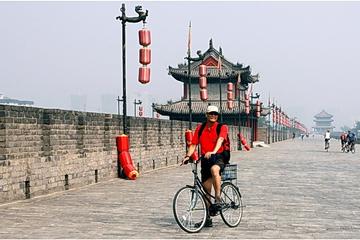
by Daniel Otero
With a space in circumference of 15 kilometers, Xuanwu Lake in Nanjing is a place for those who enjoys nature walks, runs, going to the Isle to view its man made stone gardens and greenery. The artificial mixes in just nicely with the natural. Life is beating constantly around the Lake and Nanjing Wall, considered by most a bird sanctuary so of interest to bird watchers. There is a scenic panorama of romantic-long walks and boat rides. For 30 RMB (5.81 CAD), tourists can climb the old stone steps to the top of the Wall. If you have enough stamina to walk the 15K, that’s almost one-third of a marathon!
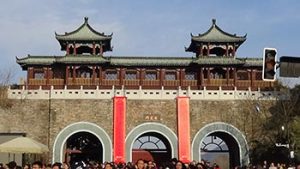 The entrance to Xuanwu Lake is gorgeous and colorful with gracious Chinese architecture. It’s located 200 meters from the Xuanwu Station metro line 1. The Lake itself has shown special historical significance since the days of the Song Dynasty; where the Navy rehearsed and trained for battle. After the construction of the Nanjing Wall, it remained a constant protection of the city and the longest uninterrupted city wall till the 17th Century.
The entrance to Xuanwu Lake is gorgeous and colorful with gracious Chinese architecture. It’s located 200 meters from the Xuanwu Station metro line 1. The Lake itself has shown special historical significance since the days of the Song Dynasty; where the Navy rehearsed and trained for battle. After the construction of the Nanjing Wall, it remained a constant protection of the city and the longest uninterrupted city wall till the 17th Century.
The Wall and Lake in conjunction is a magnet for those who enjoy revisiting the past. While Xuanwu overlooks the Zifeng Tower (13th tallest building in the world) and further into the distance, there’s the Jiming Temple. It’s a must see when visiting Nanjing.
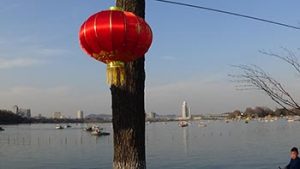 Xuanwu is a great walkabout around the Lake and Isle. Whether it’s to see it one time or the one-hundredth, it’s well worth the experience. The negatives about Xuanwu Lake are that it has turned more into a U.S. theme park, where the tickets for the boat rides are overpriced. Sadly, this has turned it into a ‘Disney’ show and not a lesson in culture or for that matter, Chinese history. It’s just too expensive and over-commercialized. It has more kiosks promoting McDonalds than Chinese food. And it’s not only the promotion of burgers. They’re also the Miami Beach Hot Dogs or the Korean elements of cuisine. Chinese culture has almost entirely been excluded from the mix of fast food menus! Outrageous as it may sound, an average Chinese lunch or meal comes to about 12 RMB (2.33 CAD). If you buy a set or combo at one of the fast food stations, prices go as high as 35 to 45 RMB (6.78 to 8.72 CAD). For the average Chinese—that’s taxing on the pocket!
Xuanwu is a great walkabout around the Lake and Isle. Whether it’s to see it one time or the one-hundredth, it’s well worth the experience. The negatives about Xuanwu Lake are that it has turned more into a U.S. theme park, where the tickets for the boat rides are overpriced. Sadly, this has turned it into a ‘Disney’ show and not a lesson in culture or for that matter, Chinese history. It’s just too expensive and over-commercialized. It has more kiosks promoting McDonalds than Chinese food. And it’s not only the promotion of burgers. They’re also the Miami Beach Hot Dogs or the Korean elements of cuisine. Chinese culture has almost entirely been excluded from the mix of fast food menus! Outrageous as it may sound, an average Chinese lunch or meal comes to about 12 RMB (2.33 CAD). If you buy a set or combo at one of the fast food stations, prices go as high as 35 to 45 RMB (6.78 to 8.72 CAD). For the average Chinese—that’s taxing on the pocket!
 I suggest, whether it’s the first time visiting or the last; to be here in China is to learn more about Chinese history/culture and admire the beautiful views. Therefore, the best way to spending money is to climb Nanjing’s historic and most beautiful wall, and walk the distance to contemplate on the gorgeous buildings, pagodas and temples far off into the distance. Then, it will be a true taste of China.
I suggest, whether it’s the first time visiting or the last; to be here in China is to learn more about Chinese history/culture and admire the beautiful views. Therefore, the best way to spending money is to climb Nanjing’s historic and most beautiful wall, and walk the distance to contemplate on the gorgeous buildings, pagodas and temples far off into the distance. Then, it will be a true taste of China.
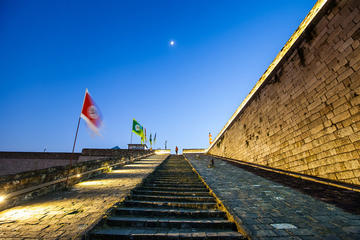
Nanjing City Highlights Private Day Tour
If You Go:
Nanjing is a city easy to access through its metro system. Traveling from the South of the city or downtown, Xinjiekou–take metro line 1 going north. Get off at the third stop. The station is identified in Chinese as well as in Romanized-Pinyin, “Xuanwumen”.

Daniel Otero is a teacher and part-time writer for Beijing Global Times and Hangzhou Weekly. He has been living in the city of Nanjing for six years. And one of the greatest reasons for this New Yorker to stay in Nanjing: its great worth of people, food and ancient history.
All photos by Daniel Otero

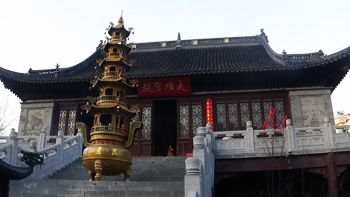
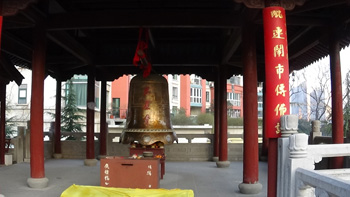 For 20 RMB the grounds hold an opportunity to walk in, and with three incense given once a ticket is purchased to light-up and bow towards all four corners of the Temple several times. After, there’s a place to put the incense upright upon the blessings. There’re other forms of blessings, like buying a red-ribbon and tying it to the veranda or tree.
For 20 RMB the grounds hold an opportunity to walk in, and with three incense given once a ticket is purchased to light-up and bow towards all four corners of the Temple several times. After, there’s a place to put the incense upright upon the blessings. There’re other forms of blessings, like buying a red-ribbon and tying it to the veranda or tree.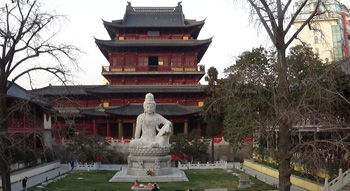 How one enters the temple and how to conduct oneself? It’s as simple as stepping over, with feet not touching the small barrier through its doors and walking over a small bridge always on the right or left, but never through the center. A person can take photos outside; however, one never takes photographs of the Buddha inside the respective buildings.
How one enters the temple and how to conduct oneself? It’s as simple as stepping over, with feet not touching the small barrier through its doors and walking over a small bridge always on the right or left, but never through the center. A person can take photos outside; however, one never takes photographs of the Buddha inside the respective buildings.


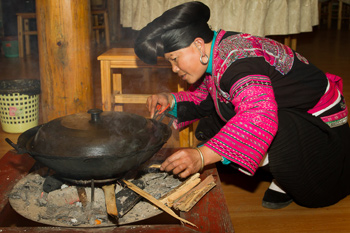 We retreated out of the icy downpour into a restaurant just in time for a traditional Chinese lunch of fresh stir-fried meat and vegetable dishes. The afternoon turned out to be a bit foggy, with filtered sun coming through the surrounding glossy wet Karst Mountains. As we walked around the lakes and canals towards the Li river, it seemed like a dreamscape. There was an ethereal glow over the city with the moist warm afternoon air.
We retreated out of the icy downpour into a restaurant just in time for a traditional Chinese lunch of fresh stir-fried meat and vegetable dishes. The afternoon turned out to be a bit foggy, with filtered sun coming through the surrounding glossy wet Karst Mountains. As we walked around the lakes and canals towards the Li river, it seemed like a dreamscape. There was an ethereal glow over the city with the moist warm afternoon air. Christmas morning was grey, but without rain. Yanhua had given me a choice of going to her friends sisters wedding or back to her Red Yao village of Huang Luo to meet her family. I wanted to see what village life was like – I had been to enough weddings – as participant and observer! Three hours later we arrived at Yanhua family’s hotel. Her mother, Pan Luifeng, in full hand knitted traditional dress, greeted us as we stepped off the bus. Yanhua changed into the Red Yao woven clothing that young and single girls wear. Shortly after we arrived the three of us headed across a swinging cable bridge to take some photographs and video at the riverside. I immediately felt I had know this family for a long time. They laughed and sang songs together while my camera clicked away. The village name, Huang Lou, actually means Long Hair. Yanhua’s mother holds the Guinness world record for the longest hair. It is very black and shinny, and wrapped around her head in a traditional bonnet style.
Christmas morning was grey, but without rain. Yanhua had given me a choice of going to her friends sisters wedding or back to her Red Yao village of Huang Luo to meet her family. I wanted to see what village life was like – I had been to enough weddings – as participant and observer! Three hours later we arrived at Yanhua family’s hotel. Her mother, Pan Luifeng, in full hand knitted traditional dress, greeted us as we stepped off the bus. Yanhua changed into the Red Yao woven clothing that young and single girls wear. Shortly after we arrived the three of us headed across a swinging cable bridge to take some photographs and video at the riverside. I immediately felt I had know this family for a long time. They laughed and sang songs together while my camera clicked away. The village name, Huang Lou, actually means Long Hair. Yanhua’s mother holds the Guinness world record for the longest hair. It is very black and shinny, and wrapped around her head in a traditional bonnet style. In the afternoon Yanhua and I took a bus trip up the narrow terraced valley to Dazhai Village. From there we hike for two hours up smooth stone steps to the “Thousand Layers to Heaven” viewpoint. The terraces truly did disappear up into the etherial fog. It was so quiet on the side of the mountain – only our heavy breathing from climbing thousands of steps could be heard. We were treated to a little sun, but the clouds thickened on our return and a cool light mist fell on our shoulders. This was Christmas Day – what a special way to spend it no matter the weather was!
In the afternoon Yanhua and I took a bus trip up the narrow terraced valley to Dazhai Village. From there we hike for two hours up smooth stone steps to the “Thousand Layers to Heaven” viewpoint. The terraces truly did disappear up into the etherial fog. It was so quiet on the side of the mountain – only our heavy breathing from climbing thousands of steps could be heard. We were treated to a little sun, but the clouds thickened on our return and a cool light mist fell on our shoulders. This was Christmas Day – what a special way to spend it no matter the weather was! Grandma sat across from me with a glint in her eye. It was that kind of glint that means “I think you are the right man for my granddaughter!” At the start of the dinner I stood up thanked everyone for making me feel so welcomed on my special day of the year to spend with family. Yanhua’s mother returned the thanks by saying I am part of the family and always welcomed!
Grandma sat across from me with a glint in her eye. It was that kind of glint that means “I think you are the right man for my granddaughter!” At the start of the dinner I stood up thanked everyone for making me feel so welcomed on my special day of the year to spend with family. Yanhua’s mother returned the thanks by saying I am part of the family and always welcomed!
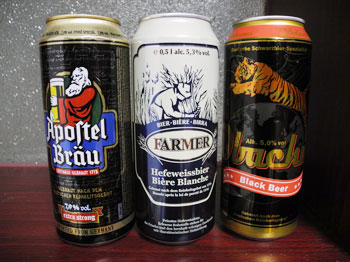 by Lawrence Hamilton
by Lawrence Hamilton Leaving Australia and returning to China meant being away from the allures of Chimay Blue and the latest in Pacific Northwest IPA’s, I guessed that being force fed the Chinese equivalent of Budweiser for 2 1/2 months would at least force me into some sort of limited sobriety. The only thing worse than being sober, is being drunk on Chinese alcohol, or so I thought.
Leaving Australia and returning to China meant being away from the allures of Chimay Blue and the latest in Pacific Northwest IPA’s, I guessed that being force fed the Chinese equivalent of Budweiser for 2 1/2 months would at least force me into some sort of limited sobriety. The only thing worse than being sober, is being drunk on Chinese alcohol, or so I thought. A small shopping centre near the ‘ghost city’ of Zhengdong introduced me to the family of Big Bear beers. Ranging from 4.7% to 12%, these beers could keep Siberia chugging through an Artic winter. I drank a can on the train back to my Kaifeng. The flavour was dark and intense. It would be best described has having the malty backbone of a brown bear and the hoppy skeletal system of a field mouse.
A small shopping centre near the ‘ghost city’ of Zhengdong introduced me to the family of Big Bear beers. Ranging from 4.7% to 12%, these beers could keep Siberia chugging through an Artic winter. I drank a can on the train back to my Kaifeng. The flavour was dark and intense. It would be best described has having the malty backbone of a brown bear and the hoppy skeletal system of a field mouse.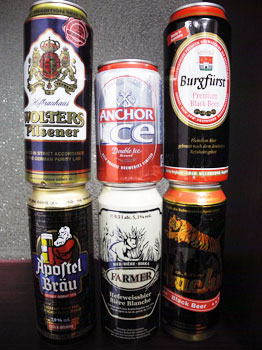 Once the trapdoor of Chinese beer is opened, turning back becomes impossible.
Once the trapdoor of Chinese beer is opened, turning back becomes impossible.
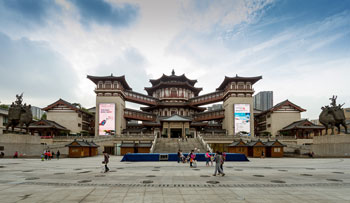 by Brian K. Smith
by Brian K. Smith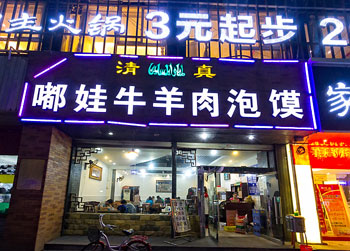 In modern times part of that history still lives on Xi’an. Over the last decade the ancient city wall has been restored back to its splendor of over 600 years ago. Within the city walls lives a large population of Muslim descendants of the Silk Road days of trade. Along with their unique customs also comes their unique food.
In modern times part of that history still lives on Xi’an. Over the last decade the ancient city wall has been restored back to its splendor of over 600 years ago. Within the city walls lives a large population of Muslim descendants of the Silk Road days of trade. Along with their unique customs also comes their unique food.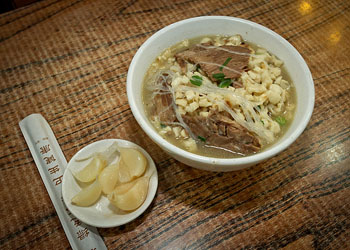 There is something about comfort food that is immediately recognizable – and this dish hit the spot. Made from pita bread, sweet potato noodles, mutton, and broth – rich with flavour and creamy in texture, it instantly makes you feel cozy and warm. Add some pickled garlic and pepper to your taste. The dish goes back to the days of the West Market at the terminus of the Silk Road. Hungry and exhausted traders arriving after months of travel could enjoy this dish in celebration of a long journey’s completion. Today a short bus ride from anywhere within the city walls will deliver you to this treat of the past. Add a local beer as your companion to this dish to complete the experience.
There is something about comfort food that is immediately recognizable – and this dish hit the spot. Made from pita bread, sweet potato noodles, mutton, and broth – rich with flavour and creamy in texture, it instantly makes you feel cozy and warm. Add some pickled garlic and pepper to your taste. The dish goes back to the days of the West Market at the terminus of the Silk Road. Hungry and exhausted traders arriving after months of travel could enjoy this dish in celebration of a long journey’s completion. Today a short bus ride from anywhere within the city walls will deliver you to this treat of the past. Add a local beer as your companion to this dish to complete the experience.